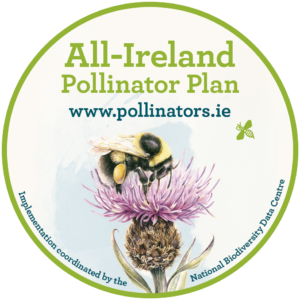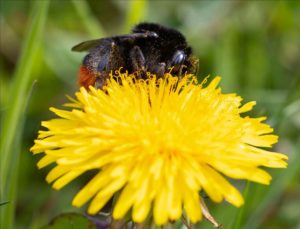All-Ireland Pollinator Plan – June 2023 newsletter

**** View this email in your browser ***

To spot this month: keep an eye out for the Red-tailed Bumblebee
This bumblebee is very common. The females are entirely black with a red tail.
Submit your bumblebee sightings
To do this month: Make sure your garden doesn’t have any hunger gaps
Try to make sure that your garden has something flowering from March to October for pollinators to feed on. In mine, it’s currently the Clover in the lawn as well as various trees and shrubs (Laburnum, Lavender, Wallflower, Catmint). The bumblebees and solitary bees are earning their keep at the minute as they’re also very busy pollinating my strawberries, tomatoes and courgettes!
Blog on making your garden pollinator-friendly
Thanks for supporting No Mow May
We are incredibly grateful to all those who supported No Mow May. It has resulted in lots of beautiful meadows emerging across the island. Some people have even reported Bee Orchids popping up in their gardens for the first time! Thanks also to An Post who helped spread the message in 2023. If you want to continue using your lawn to help pollinators, you can always cut and then let it bloom again in June! You’ll get a slightly different mix of native species appearing this time – typically dominated by White Clover and Bird’s-foot-trefoil. Reducing mowing to once a month creates what we call a ‘short-flowering meadow’. See our new guide below to help you manage both short and long-flowering meadows.
New resource: How to transform grassy areas into native meadows
Native meadows are one of Ireland’s most important habitats. They support a huge number of species above ground and in the soil. In the last few decades these fragile habitats have been disappearing fast. Our new guide, developed with native grassland experts, explains how to create and restore meadows in your local community or garden. It guides you through the gradual process of creating short-flowering or long-flowering meadows through reduced mowing and explains all the pitfalls to watch out for.
New flyer on the importance of farmland meadows
On farmland, hay meadows, however small, are incredibly rich in biodiversity. See our new flyer, explaining why they are so important. Let us know if you still have this vital habitat on your farm.
Pollinator Research in Ireland
To mark World Bee Day 2023, Prof Jane Stout (co-founder of the AIPP) provided an update on the Irish Pollinator Research Network. An incredible EIGHT pollinator PhDs have been completed by students who are part of the network in the last 12 months! Learn more about the fascinating research taking place in Ireland to underpin the All-Ireland Pollinator Plan.
School ‘pitches for pollinators’
During term time, pitches and grassy areas will be regularly mown giving kids important areas to play. However, during the summer holidays we are asking that schools consider leaving them for our pollinators. How School Groundskeepers can help:
- From the end of June until mid-August, leave pitches unmown to allow wildflowers to naturally grow and provide food for insects.
- If this isn’t possible, consider mowing just once across this period.
- It’s important that when you do mow, that you remove the grass cuttings. Our native wildflowers grow better in poorer quality soil. By removing the cuttings each summer, you slowly reduce the soil fertility. This means that each summer the pitches will become more and more flower rich for pollinators.
The summer pitch might look like long grass to humans, but chances are that amongst the grass there will be lots of little flowers that will be lifesavers to our insects. Having pitches for pollinators in schools across Ireland would create lots of pockets of excellent summer habitat for biodiversity.
If you have any contacts in schools, we’d be grateful if you can encourage them to leave ‘pitches for pollinators’.
Can you help by carrying out a Flower-Insect Timed Count (FIT Count)
FIT Counts are an important way that you can help us monitor pollinators. Download the free FIT Count App, watch a 50x50cm patch of flowers for 10 minutes and count how many insects visit. You can carry out a FIT Count anywhere, and on any flower. However, where you can, we ask that you use one of our 15 target flowers. In June, its especially useful to carry out FIT Counts on Red or White Clover.
In 2022, the average number of insects recorded on a FIT Count was 8. Why not try one where you are to see how your site compares.
For those interested, the National Biodiversity Data Centre also runs a Garden Butterfly Monitoring Scheme. You can help by counting the number of butterflies visiting your garden.

